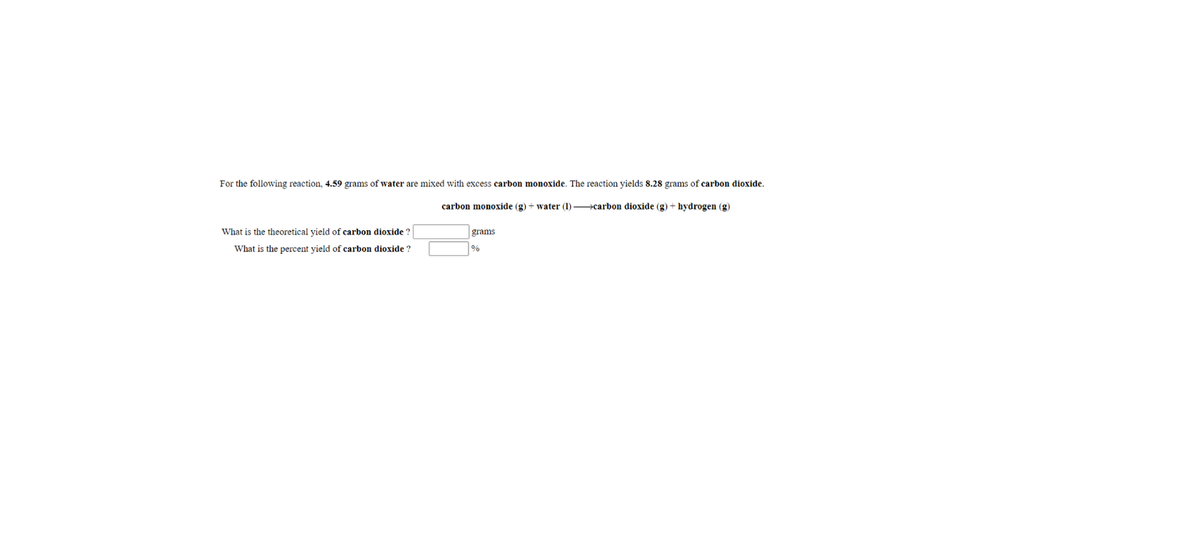For the following reaction, 4.59 grams of water are mixed with excess carbon monoxide. The reaction yields 8.28 grams of carbon dioxide. carbon monoxide (g) + water (1) >carbon dioxide (g) + hydrogen (g) What is the theoretical yield of carbon dioxide grams What is the percent vield of carbon dioxide ?
For the following reaction, 4.59 grams of water are mixed with excess carbon monoxide. The reaction yields 8.28 grams of carbon dioxide. carbon monoxide (g) + water (1) >carbon dioxide (g) + hydrogen (g) What is the theoretical yield of carbon dioxide grams What is the percent vield of carbon dioxide ?
World of Chemistry, 3rd edition
3rd Edition
ISBN:9781133109655
Author:Steven S. Zumdahl, Susan L. Zumdahl, Donald J. DeCoste
Publisher:Steven S. Zumdahl, Susan L. Zumdahl, Donald J. DeCoste
Chapter9: Chemical Quantities
Section: Chapter Questions
Problem 52A
Related questions
Question
Find the attached file

Transcribed Image Text:For the following reaction, 4.59 grams of water are mixed with excess carbon monoxide. The reaction yields 8.28 grams of carbon dioxide.
carbon monoxide (g) + water (1) >carbon dioxide (g) + hydrogen (g)
What is the theoretical yield of carbon dioxide
grams
What is the percent vield of carbon dioxide ?
Expert Solution
Step 1
Percentile yield is defined as the ratio of actual yield by theoretical yield multiplied by 100. Actual yield is the mass of the product produced in the lab while the theoretical yield is the mass of the product produced according to the mass of the reactant.
Step 2
The formula to calculate the moles of water is as follows:
Substitute for mass and for molar mass to calculate the moles of water.
Carbon monoxide is present in excess and therefore water acts as the limiting reagent and therefore the amount of produced depends on the amount of limiting reagent water.
Step by step
Solved in 4 steps

Knowledge Booster
Learn more about
Need a deep-dive on the concept behind this application? Look no further. Learn more about this topic, chemistry and related others by exploring similar questions and additional content below.Recommended textbooks for you

World of Chemistry, 3rd edition
Chemistry
ISBN:
9781133109655
Author:
Steven S. Zumdahl, Susan L. Zumdahl, Donald J. DeCoste
Publisher:
Brooks / Cole / Cengage Learning

Introductory Chemistry: A Foundation
Chemistry
ISBN:
9781337399425
Author:
Steven S. Zumdahl, Donald J. DeCoste
Publisher:
Cengage Learning

World of Chemistry
Chemistry
ISBN:
9780618562763
Author:
Steven S. Zumdahl
Publisher:
Houghton Mifflin College Div

World of Chemistry, 3rd edition
Chemistry
ISBN:
9781133109655
Author:
Steven S. Zumdahl, Susan L. Zumdahl, Donald J. DeCoste
Publisher:
Brooks / Cole / Cengage Learning

Introductory Chemistry: A Foundation
Chemistry
ISBN:
9781337399425
Author:
Steven S. Zumdahl, Donald J. DeCoste
Publisher:
Cengage Learning

World of Chemistry
Chemistry
ISBN:
9780618562763
Author:
Steven S. Zumdahl
Publisher:
Houghton Mifflin College Div

Introductory Chemistry: An Active Learning Approa…
Chemistry
ISBN:
9781305079250
Author:
Mark S. Cracolice, Ed Peters
Publisher:
Cengage Learning

Chemistry: Principles and Reactions
Chemistry
ISBN:
9781305079373
Author:
William L. Masterton, Cecile N. Hurley
Publisher:
Cengage Learning

Principles of Modern Chemistry
Chemistry
ISBN:
9781305079113
Author:
David W. Oxtoby, H. Pat Gillis, Laurie J. Butler
Publisher:
Cengage Learning